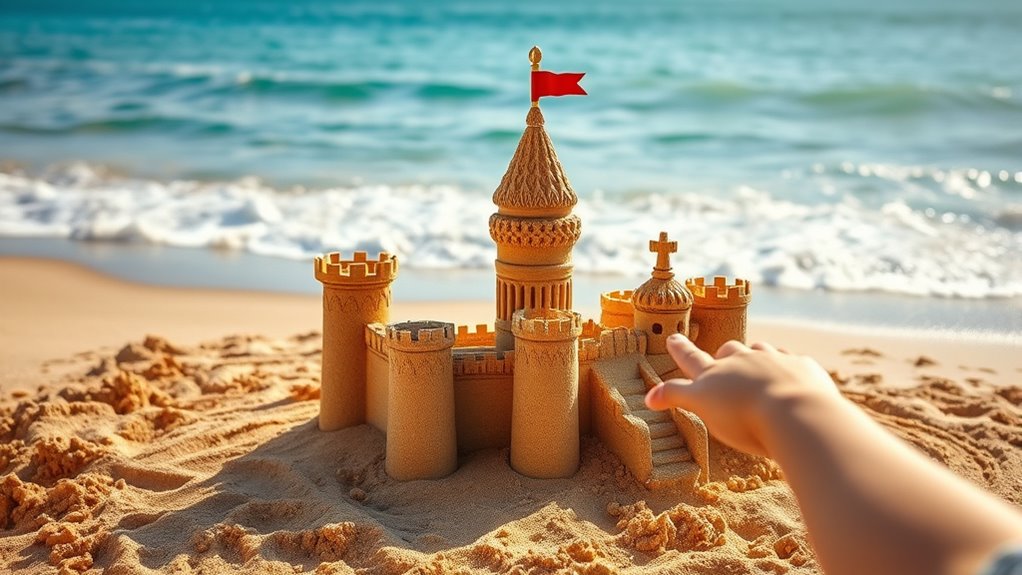To build lasting sandcastles, you need the right sand that compacts well and contains minimal shells or organic material. Adding moisture acts as a binder, filling gaps for better stability—just enough to hold without becoming muddy. Pack sand firmly in thin layers and create a broad, level base shape to support the structure. Using proper tools and carving techniques strengthens walls. Keep your castle protected from tide and wind to ensure it stands longer. Learn more to master these techniques.
Key Takeaways
- Proper moisture levels act as a natural binder, filling gaps between grains and increasing cohesion for longer-lasting structures.
- Selecting rounded, fine grains enhances stability and prevents collapsing by promoting better packing and adhesion.
- Building in thin, compacted layers reduces air pockets and creates a more stable, durable foundation.
- Carving with precise tools and controlling water application minimizes cracks and maintains structural integrity.
- Reinforcing the base, protecting from environmental factors, and designing tapered shapes improve the longevity of sandcastles.
Understanding the Composition of Sand for Building
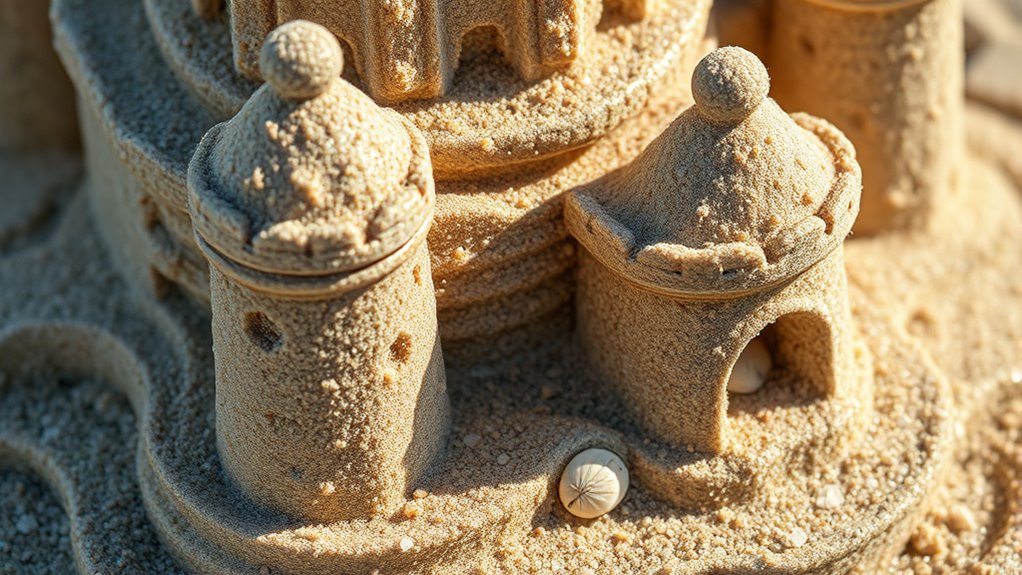
Understanding the composition of sand is essential for building durable sandcastles. When you pick your sand, look for grains that are small, rounded, and smooth, as these stick together better. Coarse or angular grains don’t pack well and can cause your structure to crumble. Fine grains help create a compact, cohesive base, making the castle more stable. Avoid sand with too many shells, pebbles, or organic material, as these weaken the overall structure. Test your sand by squeezing a handful; it should hold together without crumbling or feeling too wet. The grain size and shape of your sand significantly influence its bonding ability and overall strength. Knowing your sand’s texture and grain type helps you choose the best material for building tall, sturdy castles that withstand the test of time and weather. Additionally, understanding the moisture content of your sand is crucial, as the right amount of moisture enhances cohesion without causing runoff or slumping. Properly comparing different sand types can also improve your building results. Recognizing the toughness and durability of different sands can further aid in selecting the ideal material for long-lasting structures. Moreover, source transparency ensures that your sand is free from contaminants that could weaken your construction.
The Role of Moisture in Sandcastle Stability
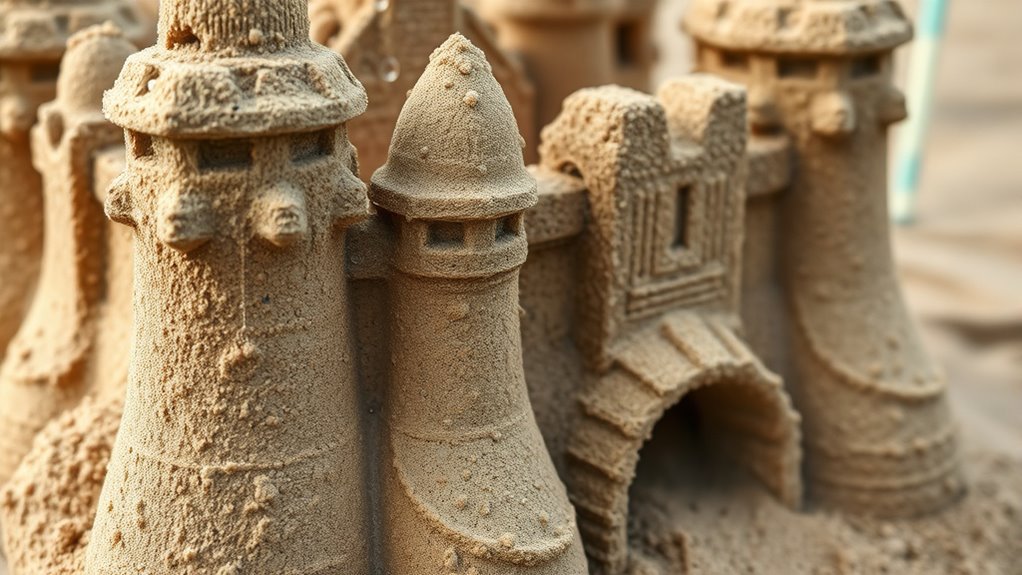
Getting the water content just right is key to building a stable sandcastle, as too much or too little can cause collapse. You can improve stability by applying moisture evenly and avoiding dry patches. Keep in mind that dried sand loses its cohesiveness, making your structure more likely to fall apart. Using proper moisture levels is essential for maintaining the integrity of your sandcastle during construction. Additionally, selecting the right soil composition can help you achieve better adhesion and structure stability. Moreover, understanding the impact of AI on everyday tech highlights how technological advancements influence our daily lives beyond just entertainment and convenience. Incorporating net worth growth hacks strategies can also inspire innovative ideas for maintaining and improving your creative projects.
Optimal Water Content
Have you ever noticed how a sandcastle’s stability depends heavily on just the right amount of water? Too little water, and the sand won’t stick together; too much, and it becomes muddy and weak. Ideal water content creates a binder that holds grains tightly without losing strength. To visualize this, consider the following:
| Water Content | Effect on Stability | Best Use Case |
|---|---|---|
| Low | Crumbly, weak | Not suitable |
| Moderate | Firm, workable | Ideal for shaping |
| High | Muddy, unstable | Too much can cause collapse |
| Excessive | Slips away, weak | Avoid |
| Perfect | Strong, moldable | Optimal for building |
Achieving the correct moisture level is essential, because moisture control directly impacts how well your sandcastle holds its shape. Proper water content creates a cohesive mixture that enhances stability, making your structure more durable in the long run. Understanding the sand grain size can also help you optimize your building technique for better results. Additionally, precise moisture regulation is crucial for creating lasting structures, especially in different environmental conditions. Getting the moisture just right ensures your castle stands tall and lasts longer.
Moisture Distribution Techniques
Ever wondered how the way you distribute moisture across your sand affects your castle’s stability? Proper moisture distribution ensures your sand bonds evenly, preventing weak spots. Instead of pouring water all at once, lightly sprinkle water over the entire area and gently mix it in. This helps achieve a uniform dampness, which is essential for strong compaction. Use your hands or tools to spread the moisture evenly, paying attention to the base and core sections. If some areas are drier, add a bit more water to maintain consistency. Keep in mind, uneven moisture can cause parts of your castle to crumble or crack. By carefully controlling and evenly distributing moisture, you enhance the overall stability and durability of your sandcastle. Effective moisture control is key to building sturdy and lasting structures, and understanding moisture distribution techniques can significantly improve your results.
Effects of Dried Sand
When sand dries out completely, its ability to hold together weakens considerably. Without moisture, the sand particles lose the glue that binds them, making structures fragile and prone to crumbling. Dry sand lacks cohesion, so your intricate details and towers may collapse easily. To prevent this, you should keep the sand damp during construction or lightly spray water on your finished castle to reinforce it. Moisture acts as a binder, filling gaps between grains and increasing stability. Dried sand also becomes less moldable, making it difficult to carve or shape precisely. Remember, the key to a durable sandcastle isn’t just in building techniques but in managing moisture levels. Keeping the sand slightly moist ensures your creation stays firm, detailed, and lasts longer against the elements. Additionally, understanding the role of moisture can help you better control the sand’s properties during construction, especially considering how AI technology is being used to develop innovative solutions in many sectors.
Techniques for Packing and Layering Sand
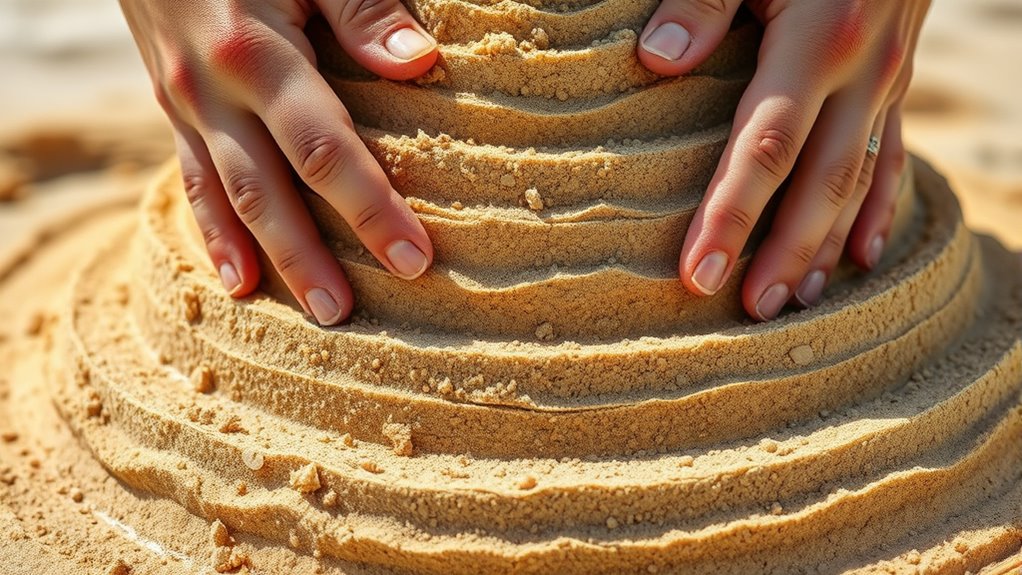
Effective packing and layering are essential for creating a sturdy, well-shaped sandcastle. To pack sand properly, scoop it firmly into your mold or hand, pressing down as you go. Use your fingers or a tool to eliminate air pockets, ensuring each layer is compacted tightly. When layering, add sand gradually, building up in thin, even layers rather than large amounts at once. This technique helps prevent collapse and creates a solid structure. Slightly moist sand compacts better, so keep the moisture level just right—not too wet or dry. Repeating the process, adding and pressing each layer firmly before adding the next, ensures consistent density. Proper packing techniques are key to achieving a durable and impressive sandcastle. Incorporating an understanding of sound vibrations can also inspire new ways to explore and enhance your building methods. Additionally, paying attention to the moisture level of the sand can significantly impact the stability of your structure, especially when considering the seasonal humidity which influences sand cohesion.
The Importance of Proper Foundation and Base Shapes

A solid foundation and well-chosen base shapes set the stage for a stable, visually appealing sandcastle. The foundation supports the entire structure, so make sure it’s broad and level. Start with a firm, compacted layer of sand that can bear the weight of your castle. When shaping the base, consider using rounded or tapered forms to promote stability. Flat, uneven bases can cause your structure to topple easily. The shape of your base influences how well the castle holds together and how tall you can build without risking collapse. Keep the base slightly wider than the upper parts to distribute weight evenly. By paying attention to your foundation and selecting appropriate base shapes, you set your sandcastle up for both durability and visual impact. Self Watering Plant Pots can help ensure your plants stay healthy during long building sessions. Additionally, understanding city dynamics can inspire more innovative and resilient designs.
Enhancing Durability With Tools and Carving Methods

Using the right tools and carving techniques can greatly boost your sandcastle’s durability. Precise carving methods help prevent cracks, while selecting the best tools ensures cleaner, sharper edges. Mastering these strategies will make your sand creations last longer and stand out.
Carving Precision Techniques
To guarantee your sandcastle withstands the test of time, focusing on carving precision is essential. Precise carving creates stronger walls and intricate details that won’t crumble easily. To achieve this, follow these key techniques:
- Use sharp tools for clean, controlled cuts, preventing unintended breakage.
- Focus on consistent pressure to avoid uneven surfaces that weaken structural integrity.
- Carve in stages, starting with rough outlines and refining details gradually to maintain stability.
Tool Selection Strategies
Selecting the right tools can considerably boost your sandcastle’s durability. Start with sturdy shaping tools like small shovels, palette knives, or plastic spatulas to carve smooth surfaces and detailed features. Use fine-tipped tools for intricate designs, which help compress the sand tightly and reduce erosion. A spray bottle or gentle water brush can keep the sand moist during carving, preventing cracks and crumbling. For structural stability, consider employing wooden dowels or sticks to reinforce thicker walls or arches. Avoid using overly sharp or fragile tools that may damage the sand or cause unintended breaks. Remember, choosing the proper tools allows you to apply controlled pressure, compact the sand effectively, and craft precise details—key factors in creating long-lasting, resilient sandcastles.
Tips for Protecting Your Sandcastle Against Tides and Wind
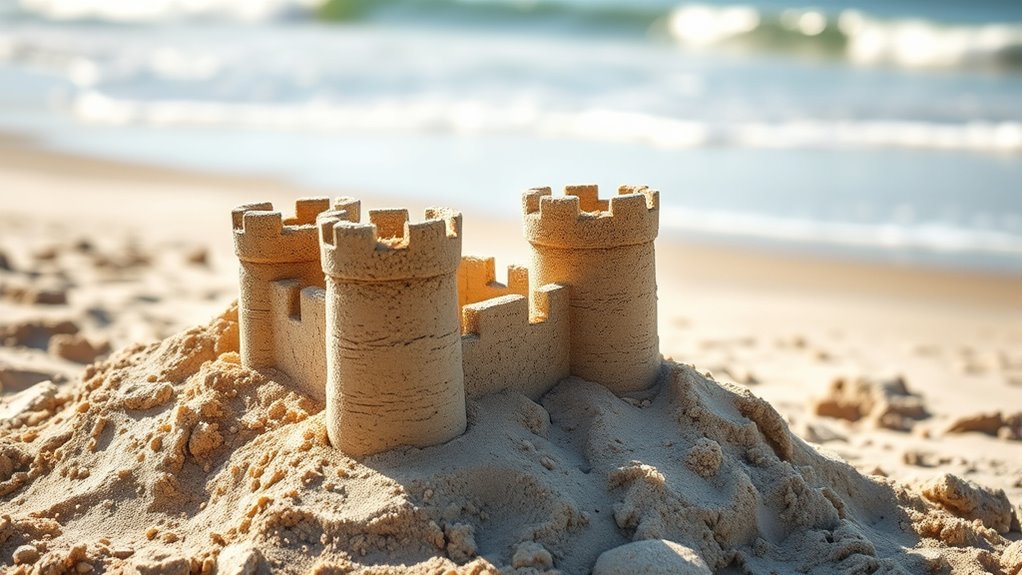
Protecting your sandcastle from tides and wind requires proactive strategies to guarantee it stays intact. First, build your castle slightly above the high-tide line to minimize exposure. Second, use moist sand, as it’s stronger and less prone to crumbling when faced with moisture or wind. Third, consider creating a small moat or barrier around your castle, which can help divert water and reduce erosion. Additionally, you can reinforce delicate structures with natural materials like seaweed or shells, which act as windbreaks. Keep an eye on the tide schedule and be ready to move or cover your creation if necessary. By implementing these practices, you give your sandcastle a better chance to withstand the forces of nature and remain a masterpiece longer.
Frequently Asked Questions
How Does the Type of Sand Affect Castle Longevity?
The type of sand you use greatly influences how long your sandcastle stays intact. Coarse sand with larger grains tends to stick together better, providing more stability. Fine, smooth sand might look better but can be less durable because its tiny grains don’t lock together as tightly. You should choose sand with a good balance of grain size and moisture content, ensuring your castle remains strong and lasts longer.
Can Adding Water Improve Sandcastle Stability Permanently?
Adding water can definitely improve your sandcastle‘s stability, but only temporarily. When you pour water onto the sand, it fills the gaps between grains, creating cohesion that helps hold the structure together. However, as the water evaporates or drains away, the stability diminishes. To make your sandcastle last longer, keep it moist during construction and avoid excessive drying or exposure to wind and sun.
What Are Common Mistakes Beginners Make in Building Sandcastles?
Did you know that over 60% of beginners struggle with basic sandcastle stability? When building, you often make mistakes like using too much water, which weakens the structure, or not compacting the sand enough, causing collapses. You might also rush shaping details without a solid foundation. To improve, take your time, keep the water balance just right, and pack the sand firmly before carving.
How Does Temperature Influence Sandcastle Durability?
Temperature plays a key role in how well your sandcastle holds up. When it’s hot, the sand dries out quickly, making it fragile and prone to crumbling. Cooler temperatures keep the sand moist longer, helping it stick better and stay sturdy. You should build your sandcastle during cooler parts of the day or keep the sand damp with water to improve its durability, ensuring your masterpiece lasts longer.
Are There Eco-Friendly Methods to Reinforce Sand Structures?
Did you know that eco-friendly materials can substantially strengthen your sandcastles? You can reinforce structures using natural binders like clay, saltwater, or organic glue made from plant extracts, which are biodegradable and safe for the environment. By choosing these methods, you not only create more durable sandcastles but also protect coastal ecosystems. So, next time, try eco-friendly solutions to build impressive, lasting creations without harming nature.
Conclusion
Now that you know the science behind sandcastles, you’re equipped to build masterpieces that defy the tides and winds. By understanding sand’s composition, moisture, packing techniques, and proper foundations, you can create a fortress that stands stronger than a mountain. With the right tools and care, your sandcastle can last longer than your memories of the beach, turning fleeting grains into a breathtaking monument that captures the magic of your skill and imagination.

